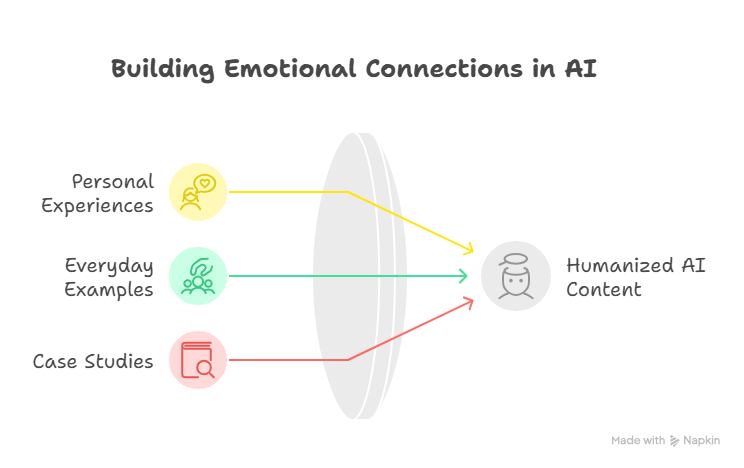Did you know that artificial intelligence is now used to create a sizable amount of online content? Even though AI is capable of creating excellent content, it frequently lacks the human element that gives it relatability and interest.
It is now more difficult to publish AI-generated content without being flagged due to the development of AI detection tools. To get around these detection tools and make sure your message is understood by your audience, it is essential to humanize AI content.
You can increase the readability and engagement of AI content by making it sound more human and natural. Humanizing artificial intelligence content is crucial in this situation because it allows you to establish a more intimate connection with your audience.
Understanding AI Detection Tools and Their Limitations
The secret to producing content that appeals to human readers is to comprehend AI detection tools. These tools are developing to recognize and flag potentially automated content as AI-generated content becomes more common.
To ascertain whether a piece of content is likely to be human-generated, AI detection tools examine a variety of factors, such as syntax, semantics, and style.
How Modern AI Content Detectors Function
Complex algorithms are used by contemporary AI content detectors to evaluate content. They search for trends and irregularities that point to content produced by artificial intelligence.
Common AI Writing Patterns That Trigger Red Flags
AI detection tools may raise red flags in response to specific writing patterns. These consist of repetitive structures, excessively formal language, and a dearth of sentimental or intimate touches.
| Pattern | Description | Impact |
|---|---|---|
| Overly Formal Language | Lack of contractions, complex vocabulary | May be flagged as AI-generated |
| Repetitive Structures | Similar sentence structures repeated | Can be identified as non-human |
| Lack of Emotional Touches | Absence of personal anecdotes or emotional language | May be seen as lacking a human touch |
Content producers can create human-like AI content that appeals to readers and evades detection by comprehending these trends and constraints.
How to Humanize AI Content: Fundamental Techniques
Several basic techniques that give AI content a human touch can be used to make it more engaging. These methods are crucial for tailoring AI content to the target audience and increasing its relatability.
Incorporating Personal Stories and Real-Life Examples
Personal narratives and real-world examples are a powerful way to humanize AI content. This method makes the information more memorable and aids in forging an emotional bond with the reader. Anecdotes or case studies, for example, can make difficult ideas more approachable.

- Talk about your own experiences with the subject.
- Use examples from everyday life to illustrate important ideas.
- Include case studies to offer concrete proof.
Adding Conversational Elements and Colloquialisms
Artificial intelligence content can sound friendlier and more natural by incorporating conversational elements and colloquialisms. To engage the reader, this entails employing contractions, informal language, and a more laid-back tone. For instance, employing expressions like “let’s take a closer look” or “you might be wondering” can help the content feel more conversational.
Varying Sentence Structure and Length
Varying sentence structure and length is crucial for maintaining the reader’s interest and making the conmore lively tent. A natural flow can be produced by alternating short and long sentences, which will make the content simpler to read and comprehend. To add variation, it’s also critical to employ various sentence structures, such as compound or complex sentences.
- To establish a natural flow, combine short and long sentences.
- Change up the sentence structures to make them more interesting and complex.
- To keep the content interesting, steer clear of repetitive sentence structures.
You can greatly raise the caliber of AI-generated content and increase its relatability and audience engagement by putting these basic strategies into practice.
Advanced Strategies for Creating Authentic-Sounding Content
Improving AI content for human connection necessitates a sophisticated strategy that goes beyond simple methods. Using sophisticated techniques that concentrate on producing a human-like experience is essential to making AI-generated text more relatable and interesting.
Infusing Emotional Language and Personality Traits
Adding emotional language and personality traits to AI content is a useful method of humanizing it. This entails employing language that expresses attitudes and feelings in order to make the information more approachable and interesting. For example, employing storytelling techniques or vivid imagery can help establish a stronger bond with the reader.
Embracing Imperfections and Natural Writing Flow
AI-generated content can also sound more real by accepting its flaws. This entails permitting minor alterations in vocabulary, tone, and sentence structure that can replicate the organic flow of human writing. This makes the content less robotic and more dynamic.
Tailoring Content to Specific Audience Demographics
Another cutting-edge method for producing content that sounds authentic is to customize AI content to particular audience demographics. This entails comprehending the target audience’s needs, preferences, and cultural quirks and modifying the content appropriately. The intended readers will find the content more interesting and relevant as a result.
Content producers can greatly improve the engagement and authenticity of AI-generated content by putting these cutting-edge techniques into practice, giving it a more relatable and human-like appearance.
Conclusion
In the current digital environment, it is essential to produce content that appeals to readers. You can create strategies to humanize AI content and make it more relatable and interesting by learning about AI detection tools and their limitations.
You can accomplish this by using the strategies covered, like using personal anecdotes, conversational components, and emotive language. By using these techniques, you can create excellent content that sounds genuine and natural, which will strengthen your bond with your audience.
Focus on accepting flaws and customizing your content for particular audience segments if you want to humanize AI content. Your chances of grabbing readers’ attention and building a devoted following will rise as a result of your ability to provide a more tailored experience.
By putting these tactics into practice, you’ll be well on your way to becoming an expert at humanizing AI content and maintaining your competitive edge in the rapidly changing digital market.
FAQ
What is the main goal of humanizing AI content?
The primary objective of humanizing AI content is to make it sound more relatable, engaging, and authentic, allowing it to bypass AI detection tools and resonate with human readers.
How do AI detection tools work, and what are their limitations?
AI detection tools analyze content for patterns and characteristics typical of AI-generated writing, such as overly formal language or repetitive structures. However, these tools are not foolproof and can be evaded by incorporating human-like elements and nuances into the content.
What are some effective techniques for humanizing AI content?
Techniques for humanizing AI content include incorporating personal anecdotes, using conversational language and colloquialisms, varying sentence structure, and infusing emotional language to create a more natural and engaging tone.
How can I make my AI content more conversational and relatable?
To make AI content more conversational, you can use everyday language, ask rhetorical questions, and incorporate contractions and colloquial expressions, making the content feel more approachable and human-like.
What role does audience demographics play in humanizing AI content?
Understanding your target audience’s demographics, preferences, and behaviors is crucial in tailoring your AI content to their needs, making it more relevant, engaging, and authentic.
Can humanizing AI content improve its overall quality and engagement?
Yes, humanizing AI content can significantly enhance its quality and engagement by making it more relatable, authentic, and enjoyable to read, ultimately leading to better reader interaction and connection.
How can I balance the use of AI tools with the need for human-like content?
To strike a balance, use AI tools as a starting point, and then refine and edit the content to incorporate human elements, such as personal touches, emotional language, and varied sentence structures, ensuring the final output sounds natural and engaging.




